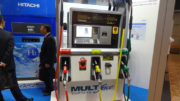 A Fuel Cell is an electrochemical device similar to a battery, but differing from the latter in that it is designed for continuous replenishment of the reactants consumed; i.e. it produces electricity from an external fuel supply as opposed to the limited internal energy storage capacity of a battery.
A Fuel Cell is an electrochemical device similar to a battery, but differing from the latter in that it is designed for continuous replenishment of the reactants consumed; i.e. it produces electricity from an external fuel supply as opposed to the limited internal energy storage capacity of a battery.
Typical reactants are hydrogen on the anode side and oxygen on the cathode side. In contrast, conventional batteries consume solid reactants and, once these reactants are depleted, must be discarded or recharged.
Typically in fuel cells, reactants flow in and reaction products flow out, and continuous long-term operation is feasible virtually as long as these flows are maintained. The Fuel Cell will produce energy in the form of electricity and heat as long as fuel is supplied.
A fuel cell consists of two electrodes sandwiched around an electrolyte. Oxygen passes over one electrode and hydrogen over the other, generating electricity, water and heat.
Hydrogen fuel is fed into the “anode” of the fuel cell. Oxygen (or air) enters the fuel cell through the cathode. Encouraged by a catalyst, the hydrogen atom splits into a proton and an electron, which take different paths to the cathode. The proton passes through the electrolyte. The electrons create a separate current that can be utilised before they return to the cathode, to be reunited with the hydrogen and oxygen in a molecule of water.
A fuel cell system, which includes a “fuel reformer”, can utilise the hydrogen from any hydrocarbon fuel – from natural gas to methanol, and even gasoline. Since the fuel cell relies on chemistry and not combustion, emissions from this type of a system would still be much smaller than emissions from the cleanest fuel combustion processes.
In fact fuel cells running on hydrogen derived from a renewable source will emit nothing but water vapour.
The production of fuel cells is more than just a dream, research in to fuel cells is continuing by major manufacturers around the world with Australia’s CSIRO being a major player as well.
Hydrogen-powered vehicles can eventually offer a practical solution to the problem of automotive pollution while reducing the world’s dependence on oil. George Bush has recently committed millions of US tax payer dollars to research development of both Hydrogen and Fuel Cell manufacture.




